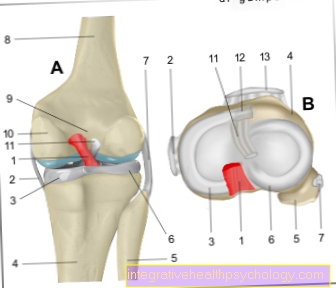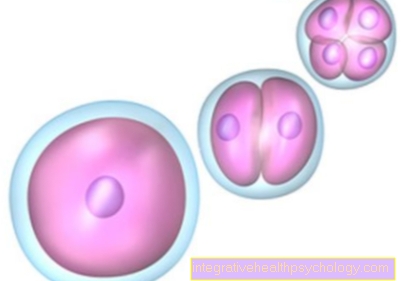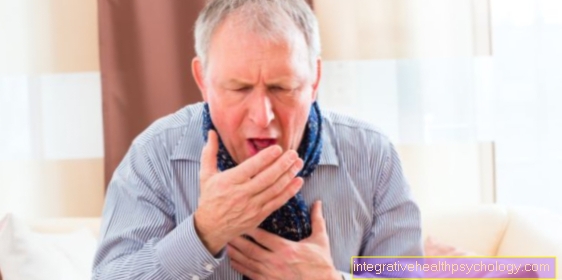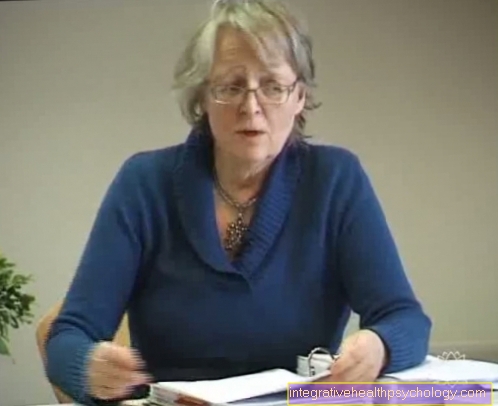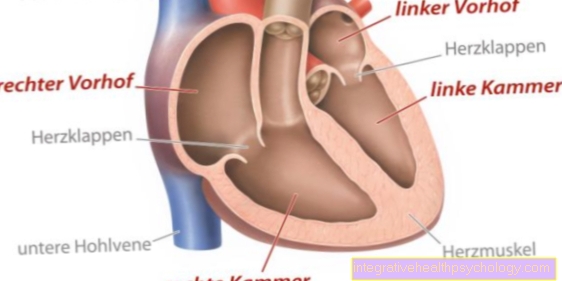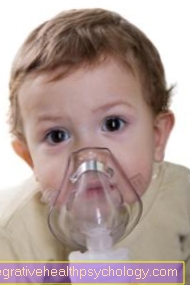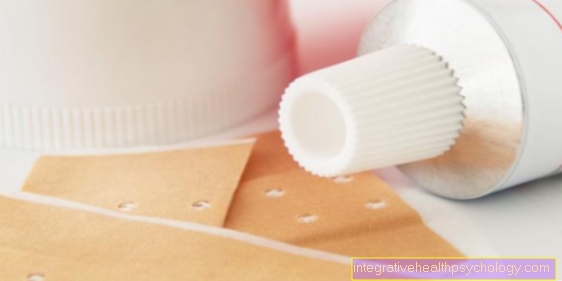Cough in child
definition
Coughing is one of the most common symptoms, both in children and adults, and as a result, a regular reason to see a doctor. Mostly a cough is a symptom of a respiratory disease (throat, throat, nose, windpipe) or of the lungs. As a rule, a cough is a sign of a harmless, mostly viral infection, but serious or dangerous illnesses can also be indicated by coughing. For this it is important to watch out for certain warning signs, such as sputum (for example mucus or blood), certain triggers (especially with allergies and asthma) and the type of cough or long-term cough. A persistent cough of more than three weeks would be suspect. Other symptoms, such as fever, can also indicate a dangerous course and should result in a more detailed medical examination.

causes
Cough occurs when the nose, sinuses, upper or lower airways are irritated. There are specific receptors that react to certain stimuli and thus trigger a cough. Possible causes can be: cold air, inhaled particles (e.g. smoke or dust), increased mucus, citric acid, as well as other foreign and some endogenous substances, such as inflammatory substances (e.g. bradykinin, tachykinin and prostaglandin E2), which the body causes during inflammatory reactions, so, among other things, in infections. About the tenth cranial nerve (Vagus nerve) the stimulus is passed on from the receptor to the brain, where the cough is initiated. Primarily, this happens in the cough center of the brain stem and is considered a reflex; Coughing is therefore not an arbitrarily controllable event.
The aim of the cough is to clear the airways when the other mechanisms that are always active fail. Normally, the movement of the so-called ciliated epithelium, which lines the entire airway, is enough to remove mucus and foreign bodies. Mucus is transported towards the oral cavity by microscopic hairs that beat rhythmically in the same direction. In the case of very thick mucus, as can occur in muscoviscidosis, or with increased mucus, this effect is not sufficient. The mucus has to be coughed up.
diagnosis
When looking for the cause and making a diagnosis, various things must be considered. It is particularly important to observe in which situations the cough occurs, the accompanying symptoms and the type of cough. This can already give clues to the cause, so attention should be paid to when and where the cough occurs. For example, it can occur more frequently in situations of physical exertion, at certain times of the day or in certain places.
Diagnosing a cough generally includes listening to the lungs with a stethoscope and examining the mouth and throat. Depending on the symptoms, the following can also be added: smear of the nasal mucosa, sampling and analysis of the sputum, an x-ray of the lungs or a lung function diagnosis.
Concomitant symptoms
Often there are other symptoms that can provide clues about the underlying disease. Slimy sputum, a runny nose (Rhinorrhea) and fever generally indicate an infection. A doctor should be consulted, especially if you have a fever, as this can be an indication of a more serious illness. Other warning signs for which a doctor should be consulted are shortness of breath (Dyspnea), bloody sputum (Hemoptysis) and severe chest pain. In the case of rashes, one can also think in the direction of infection, especially many childhood diseases are associated with rashes, but an allergy can also be the cause. A pediatrician should be visited.
A frightening but generally harmless side effect of severe coughing fits are so-called Hyposphagma. This is called bleeding into the white conjunctiva of the eyes. The increased pressure when coughing causes small blood vessels in the eye to burst and cause bleeding. Usually these disappear on their own after a few days.
Bad breath
Bad breath is a very non-specific symptom, even if it occurs in addition to a cough. Bad breath can be an indication of a mostly bacterial infection of the respiratory tract or the mouth and throat, but a more common cause is poor oral and dental hygiene.
fever
Fever associated with a cough indicates a respiratory infection. In children, this is usually an upper airway infection. Usually a virus is the cause and the fever does not exceed the limit of 40 ° C. A viral infection cannot be treated with antibiotics, so only symptomatic treatment is possible. A visit to the doctor can still be useful and should not be omitted if you are unsure.
A high fever of 40 ° C or higher is more likely to indicate bacteria as the cause of the infection. A doctor should be consulted. If bacteria are the cause of the cough, treatment with antibiotics makes sense.
Please also read our topic pages fever and Fever in the toddler
Forms of cough
Barking cough
Barking coughs occur in particular in the form of coughing fits, in which the children can hardly breathe during the fit. The cough sounds similar to a dog's barking, but it is mostly a dry cough. Typically, barking, dry cough occurs in pseudo croup (Subglottic laryngitis), a viral infection with cold symptoms. At the same time, a wheezy cough may appear. Coughing fits of barking cough also occur with whooping cough.
Find out more about the symptoms of croup at the following link: Pseudo croup
Dry cough
Dry cough can occur with many diseases. Often it is just a dry cough without any deeper meaning. However, a dry cough can also indicate the following clinical pictures: asthma (attack-like occurrence, especially at night or during exertion, sometimes slimy with glassy secretion, sometimes whistling), ingestion (aspiration, especially in small children), pneumonia (dry to slimy), inhalation of irritants (mostly in combination with reddened eyes and runny nose) or in the context of pseudo croup.
Slimy cough
Slimy cough is usually a sign of infection, so it is typical of bronchitis and pneumonia. Furthermore, this occurs in the important but rare disease of Cystic fibrosis (cystic fibrosis).
In addition, there is a slimy cough with clear, glassy secretion in asthma.
Find out more about the Pneumonia in Children.
Wheezing cough
Wheezing cough can in principle occur with almost any type of cough and is a sign of great strain when coughing. It can be very difficult to tell the difference between a wheezing and a barking cough. Since it is a sign of great exertion, wheezing cough can occur with any type of cough, such as asthma, whooping cough, and pseudo croup.
Wheezing cough
A wheezing cough is a sign of obstruction, a narrowing of the airways. This occurs in certain types of bronchitis and pneumonia, but is also typical in asthma. In addition to the wheezing cough, a wheezing sound can often be heard when breathing (Wheezing). A whistling cough can also occur in pseudo croup in combination with a barking cough.
For more information on the subject, see our article on the subject asthma
General measures
The main focus of therapy is symptomatic treatment that is intended to alleviate the symptoms. Since in children there is usually a viral infection behind the cough, it is often impossible to do more. If certain warning symptoms appear or if the general condition of the child is very poor, a pediatrician should be consulted.
Drinking enough is particularly important for symptomatic treatment. As long as the child can produce enough saliva to keep the mucous membranes moist, the urge to cough is less strong. In addition, drinking tea or milk with honey is recommended. In addition, a large number of sugar-free cough drops are offered in the pharmacy, which on the one hand help to keep the mucous membranes moist and on the other hand can relieve the urge to cough through herbal ingredients.
Symptom-reducing drugs should be used depending on the type of cough. If the cough is dry, a dry cough and occurs especially at night, so-called cough suppressants (Antitussives) which can inhibit or suppress the urge to cough (e.g. Capval).
Cough suppressants like these should not be used if the cough is productive (slimy) or if it is accompanied by a narrowing of the airways (obstruction, e.g. in asthma, bronchitis). In the case of a slimy, stubborn cough, expectorant drugs can be used, such as Ambroxol, ivy leaf dry extract and many more.
In addition to symptomatic therapy, causal therapy for the underlying disease should also be carried out if possible.
Inhale
Inhaling a cough, whether slimy or dry, can quickly provide relief and reliably relieve the symptoms. This should be done with hot water and possibly added substances such as chamomile extract. The moistening of the mucous membranes has a particularly soothing effect. It is often advisable to start inhaling early after the cough has started, as it can prevent lengthy processes.
There are a few things to keep in mind - especially with children:
Children under two to three years of age cannot yet safely inhale with hot water vapor. Even with older children, a supervisor should always be present so that no mishaps happen and the child does not get burned. Inhaling for too long should also be avoided. Inhaling should be done in such a way that hot water is poured into a saucepan or an inhalation device. Chamomile extract or a teaspoon of salt can be added. Essential oils and especially peppermint oil should be avoided as it can irritate the sensitive mucous membranes of children. After the water has cooled a little, you should bend over the steam and inhale with deep breaths for two to five minutes. Distraction maneuvers, such as reading stories at the same time, can help the child to better tolerate the inhalation.
For older and younger children alike, a pot with hot water and some chamomile extract can be placed in the room for twenty to thirty minutes to humidify the air, ideally with the doors and windows closed. In the case of children with house dust allergies, however, room humidification should not be used, as house dust mites, which cause the allergy, can multiply better in moist air.
Asthmatics should not inhale with hot water as this can trigger an asthma attack!
As an alternative to hot water, electric inhalers and masks are available that atomize cold or warm salt water so that the steam can be inhaled. This option is more effective, especially with deep-seated mucus, as the droplets are smaller and can penetrate deeper into the airways.
How can you relieve night coughs?
Nocturnal cough can occur particularly with infections and asthma. If it occurs in the context of asthma, you should think about increasing the drug dose together with the pediatrician in charge. It is important to make sure that the medication is taken regularly to effectively reduce the existing inflammation of the lower airways. Humidifying the air in the room does not make sense in the case of asthma, especially if it is an allergic asthma, as house dust mites, which can trigger asthma attacks, can multiply particularly well in warm, humid room air.
When coughing due to infections, however, the room air can be moistened with a pot of hot water before going to bed. You should also drink enough and inhale it. Alternatively, the child can still bathe in the evening, the mucous membrane is also moistened by water vapor. Only in the case of a dry cough can an antitussive drug (Antitussive), but a pediatrician should be consulted beforehand. Unfortunately, even with optimal care, nocturnal coughing in the case of infections cannot be prevented, but one has to wait. If you are unsure, you should consult a pediatrician.
When should i see a doctor?
When it makes sense to see a doctor depends in particular on the form of the cough, the accompanying symptoms and the duration of the symptoms. First, see a pediatrician if parents feel unsure. In general, however, it is not necessary to drive to the emergency room at night.
A doctor should be consulted quickly if certain warning symptoms ("red flags") appear. These include a high fever, shortness of breath, severe chest pain, bloody sputum, and a sudden cough that looks unusual and a cough that lasts for more than six weeks.
Home remedies
Many different home remedies for coughing can be used as symptomatic therapy. It is particularly important to ensure that there is sufficient fluid intake. Tea is particularly helpful here, especially lightly sweetened linden blossom tea, which does not irritate or dry out the mucous membranes and has anti-inflammatory properties. Alternatively, chamomile tea or milk with honey can be used. The children like the natural sweetness of honey very much and at the same time the anti-inflammatory properties of honey help.
Inhalation and warm, moist air are generally good for infections. Sea salt or chamomile extract can also be added. Salt prevents the mucous membranes from drying out in the long term and chamomile has an anti-inflammatory effect. Alternatively, eucalyptus, sage or thyme can also be used. All of these substances loosen mucus and help the body survive the inflammation. Peppermint and other essential oils should be avoided in children, as these irritate the mucous membranes. Especially with a blocked nose and concomitant sinusitis, as well as with a lot of mucus due to an infection, rinsing the nose with salt water or a red light lamp can help.
For more information on home remedies for coughs, see our article Home remedies for coughs.
Onion juice
Onion juice is considered an old home remedy for coughs and can help children drink enough fluids. At the same time, it soothes the irritated mucous membranes. To make it, an onion is finely chopped, put into a mason jar with a little sugar or honey and placed in a warm place for five to six hours. The mixture should be shaken well in between. After a while, enough onion juice will form, which can be poured off using a sieve. The juice can be given several times a day and can be kept in the refrigerator for a few days.
Caution: onion juice is generally only recommended for children from one year of age, as honey should not be given beforehand and the onion juice itself can have a strong flatulence.
Duration of the cough
Depending on the cause, a cough in children can last different times. Everything is possible, from a single event in the case of acute irritation, over a few days in the case of a simple infection, to weeks in the case of a complicated infection or a chronic illness. In general, a chronic cough is spoken of after six to eight weeks. After a period of six weeks, an intensive diagnosis should be initiated by a doctor, since a cough caused by a simple flu-like infection usually does not last longer than six to eight weeks. Among the infectious diseases, whooping cough (Pertussis) the exception, which can take a very long course (up to ten weeks).
Are you further interested in Whooping cough? Read our article on the subject.
In the case of chronic diseases such as asthma or cystic fibrosis, the attending physician should be consulted in order to check the medication if there is an increased cough. In order to combat the cough efficiently, the medication must be taken reliably as prescribed.

